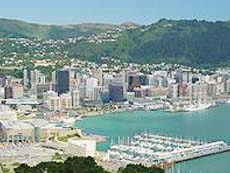Brief Introduction
New Zealand is an island nation in the South Pacific Ocean, located south of the equator in the Southern Hemisphere, and marking the eastern boundary of the Tasman Sea, a portion of the Pacific Ocean that separates New Zealand and the nearest large landmass, Australia, by a distance of about 1,600 km (1,000 mi). New Zealand includes two large islands that constitute most of its landmass, as well as numerous small islands. New Zealand administers two overseas territories, Tokelau and Ross Dependency (in Antarctica). The self-governing entities of Niue and the Cook Islands are in free association with New Zealand, which handles their foreign affairs and defense as requested.
New Zealand is known for its scenic landscapes of snowcapped mountains and rolling green pastures. Its image as a farming outpost stems from the traditional importance of agriculture to the economy as well as the low population density in most areas. However, the majority of New Zealanders live in urban areas, and many now earn a living in service industries such as tourism. The capital of New Zealand is Wellington. The largest and most cosmopolitan city is Auckland.
New Zealand is part of the Pacific Islands, or Oceania, a grouping of thousands of islands in the Pacific Ocean. The South Island and the North Island of New Zealand are Oceania’s second and third largest islands, respectively. New Zealand is considered part of Polynesia, one of three major divisions of the Pacific Islands.
The total land area of New Zealand is 267,990 sq km (103,470 sq mi), about the same size as Japan or the British Isles. The North and South islands make up almost the entire area of the country. Separating these islands is Cook Strait, a channel between the South Pacific Ocean on the east and the Tasman Sea on the west. The islands stretch along a predominantly northeast by southwest axis. Their length from north to south is about 1,600 km (1,000 mi), and their maximum width from east to west is 450 km (280 mi)
Land is one of the country’s most valuable resources. Much of the soil is not naturally fertile, however, and has to be supplemented with fertilizers for crop cultivation. More than half of the land area is either cropland or pastureland. Most of the arable land is found on the east coasts of both islands, in particular the Canterbury Plains. Pastures for livestock grazing dominate in north-central and western North Island and southern South Island.
About 30 percent of the land area is forested. The country has 6.4 million hectares (15.8 million acres) of old-growth forest, much of which is designated for preservation. In addition, some forests are plantations of imported species such as the radiata pine. The western Southern Alps of the South Island constitute the largest forested area of the country and include extensive areas of native forest. The North Island has native forest mainly in more remote areas, notably around Mount Taranaki and in isolated pockets of Northland.
In 1840, New Zealand was de-linked from Australia, but in 1907 it became a separate, independent country, under the British Crown, and when the British Commonwealth of Nations was set up in 1931 it became one of the founding members and is still a member.
The majority of the population (74 percent) is Anglo-Saxon, with the indigenous Maoris making up only 10 percent of the population, others who neither Maoris nor Anglo-Saxons make up four percent, an ethnic group that is made up of ethnic Indians and Chinese.
Seventy percent of the population is Christians, and the rest belong to different religious denominations.
Muslims in New Zealand
Muslim migration to New Zealand started in 1910, when the first waves of immigrants from the Indian subcontinent started to arrive, as workers in search of livelihood.
Since they were not allowed then to bring their wives and other family members with them, they remitted their earning to their families back home, visitng them from time to time.
However, in the mid-1940s, the Muslims living in New Zealand, for the first time, began to bring their wives from the subcontinent.
These womenfolk were mostly housewives, though some of them took up employment as menial workers or domestic helpers, when their husbands were at work.
But while the first generation of Muslim women in New Zealand had to contend with loneliness and confinement to the home, the second generation is faced with a different set of problems, namely maintaining a balance between Islamic tenets and precepts, and the secular education that is imparted on them at schools, with all its concomitant moral and religious implications.
One result of the latter is the loss of respect for parents, who, the youth consider as backward and unschooled.
Other problems faced by the Muslim woman in New Zealand include the preservation of the Islamic identity, racial discrimination, absence of Islamically lawful food, inability to be married to the right person, and even in wearing the proper school uniform.
None the less things are beginning to improve for the Muslim women of New Zealand, in that they have started to organize themselves, and are, in fact, holding an annual assemblies, during which they are able to project some of the problems facing them in the society.
They also hold regular seminars and camps, at which they are able to learn more about their Muslim faith, and debate some of the issues affecting them.
Though some of the Muslim women have made worthwhile academic accomplishments, and some of them have established themselves in various fields, generally there is a tendency toward trying to achieve more in the field of religion, so that they could preserve their Islamic identity.


 Home
Home Discover Islam
Discover Islam Quran Recitations
Quran Recitations Lectures
Lectures
 Fatwa
Fatwa Articles
Articles Fiqh
Fiqh E-Books
E-Books Boys & Girls
Boys & Girls  Hajj Rulings
Hajj Rulings Hajj Fatwas
Hajj Fatwas














